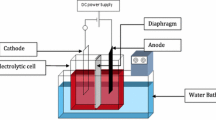Abstract
The effect of Mo6+ on the current efficiency, deposit quality, surface morphology, crystallographic orientations and polarisation behaviour of the cathode during electrodeposition of nickel from sulfate solutions was investigated. Mo6+ did not have a significant effect on current efficiency over the concentration range 2–100 mg dm−3. However; a decrease in current efficiency by a magnitude of more than 20% was seen at 500 mg dm−3. The quality of the nickel deposit with reference to the visual appearance and contamination level varied with varying concentration of Mo6+; this was also reflected in the morphology and crystallographic orientations of the deposits. Addition of Mo6+ to the electrolyte introduced two new crystal planes i.e., (220) and (311). Depolarisation of the cathode was noted at lower concentrations of Mo6+ (2–40 mg dm−3) whereas polarisation of the cathode was observed at Mo6+ concentration >40 mg dm−3 .The effect of Mo6+ on parameters such as Tafel slope (b), transfer coefficient (α) and exchange current density (i 0) were also determined.


Similar content being viewed by others
References
Essin O, Alfimova E (1935) Trans Electrochem Soc 68:417
Yuza V, Kopyl I (1940) J Phys Chem 14:1071
Salt F (1947) Disc Faraday Soc 1:169
Gorbachev A, Yurkevich Y (1954) J Chem Phys 28:1120
Fischer H, Seipt M, Morolock G (1955) Z Elektrochem 59:440
Yang L (1950) J Electrochem Soc 97:241
Clark G, Simonson S (1951) J Electrochem Soc 98:110
Wyllie MRF (1948) J Chem Phys 16:52
Evans DJ (1958) Trans Faraday Soc 59:1086
Cliffe DR, Farr JPG (1964) J Electrochem Soc 111:299
Epelboin J, Froment M, Maurin G (1969) Plating 56:1556
Reddy AKN (1973) J Electroanal Chem 6:141, 153, 159
Gogia SK, Das SC (1988) Met Trans B 19:6
Gogia SK, Das SC (1991) J Appl Electrochem 21:64
Holm M, Keefe TJO (2000) Met Trans B 31:1203
Zhou Z, Holm M, Keefe TJO (1997) In: Proceedings Nickel-Cobalt 97, CIM, Sudbury, Canada
Tripathy BC, Das SC, Singh P, Hefter GT, Muir DM (2001) J Appl Electrochem 31:573
Mohanty US, Tripathy BC, Singh P, Das SC (2002) Minerals Eng 15:531
Mohanty US, Tripathy BC, Singh P, Das SC (2002) J Electroanal Chem 526:63
Mohanty US, Tripathy BC, Singh P, Das SC (2004) J Electroanal Chem 566:47
Tripathy BC, Singh P, Muir DM (2001) Met Trans B 32:395
Mohanty US, Tripathy BC, Singh P, Das SC (2001) J Appl Electrochem 31:579
Mohanty US, Tripathy BC, Singh P, Das SC (2001) J Appl Electrochem 31:969
Zeng Y, Yao SW, Guo HT (1994) Platinum Surf Fin (Chinese) 16:9
Zeng Y, Yao SW, Gao HT (1995) Platinum Surf Fin 82:640
Mark HF, Othermer DF, Overberger CG, Seaborg GS (1981) Kirk Othmer encyclopedia of chemical technology, vol. 15, 3rd edn. A Wiley Interscience Publication, p 670
Swansou T (1953) Natl Bur Stand (U.S.) Circ 539(1):13
Ernst DW, Holt ML (1958) J Electrochem Soc 105:686
Chassaing E, Quang KV, Wiart R (1989) J Appl Electrochem 19:839
Zeng Y, Yao SW, Guo HT (1995) Act Phys Chem Sin (Chinese) 11:351
Zeng Y, Yao SW, Guo HT (1997) Chem J Chem 15:193
Souchay P (1963) Polyanions and polycations. Gauthier-Villars, Paris
Pope MT (1983) Heteropoly and isopoly oxometallates. Springer-Verlag, Berlin
Van Veen JAR, Sudemeiger O, Emeis CA, de Wit HJ (1986) J Chem Soc Dalton Trans 1825
Peterson L, Anderson I, Ohman L (1986) Inorg Chem 25:4726
Van Veen JAR, Hendris PAJM, Andra RR, Romers EJGM, Wilson AE (1990) J Phys Chem 94:5282
Hoare JP (1986) J Electrochem Soc 133:2491
Hoare JP (1987) J Electrochem Soc 134:3102
Dorsch RK (1969) J Electroanal Chem 21:495
Fleischmann M, Reintjes AS (1984) Electrochim Acta 29(1):69
Horkans J (1979) J Electrochem Soc 126:1861
Pushpavanam M, Balakrishnan K (1996) J Appl Electrochem 26:283
Fukushima H, Akiyama T, Nakakoji H, Higashi K (1979) Hyomen Gijutsu 30(11):600
Piatti RCV, Arvia AJ, Podesta JJ (1969) Electrochim Acta 14:541
Hurlen T (1975) Electrochim Acta 20:499
Farndon EE, Walsh FC, Campbell SA (1995) J Appl Electrochem 25:574
Acknowledgements
USM would first like to thank the CSIR for granting him a research fellowship. The authors thank P. Fallon for assistance with SEM, K. Seymour for XRD and T. B. Issa for general assistance throughout the work. The authors also thank the Director, Regional Research Laboratory Bhubaneswar for his kind permission to publish this paper. Financial support was partly received from the A. J. Parker Cooperative Research Centre for Hydrometallurgy.
Author information
Authors and Affiliations
Corresponding author
Rights and permissions
About this article
Cite this article
Mohanty, U.S., Tripathy, B.C., Singh, P. et al. Role of Mo6+ during nickel electrodeposition from sulfate solutions. J Appl Electrochem 38, 239–244 (2008). https://doi.org/10.1007/s10800-007-9431-0
Received:
Revised:
Accepted:
Published:
Issue Date:
DOI: https://doi.org/10.1007/s10800-007-9431-0




